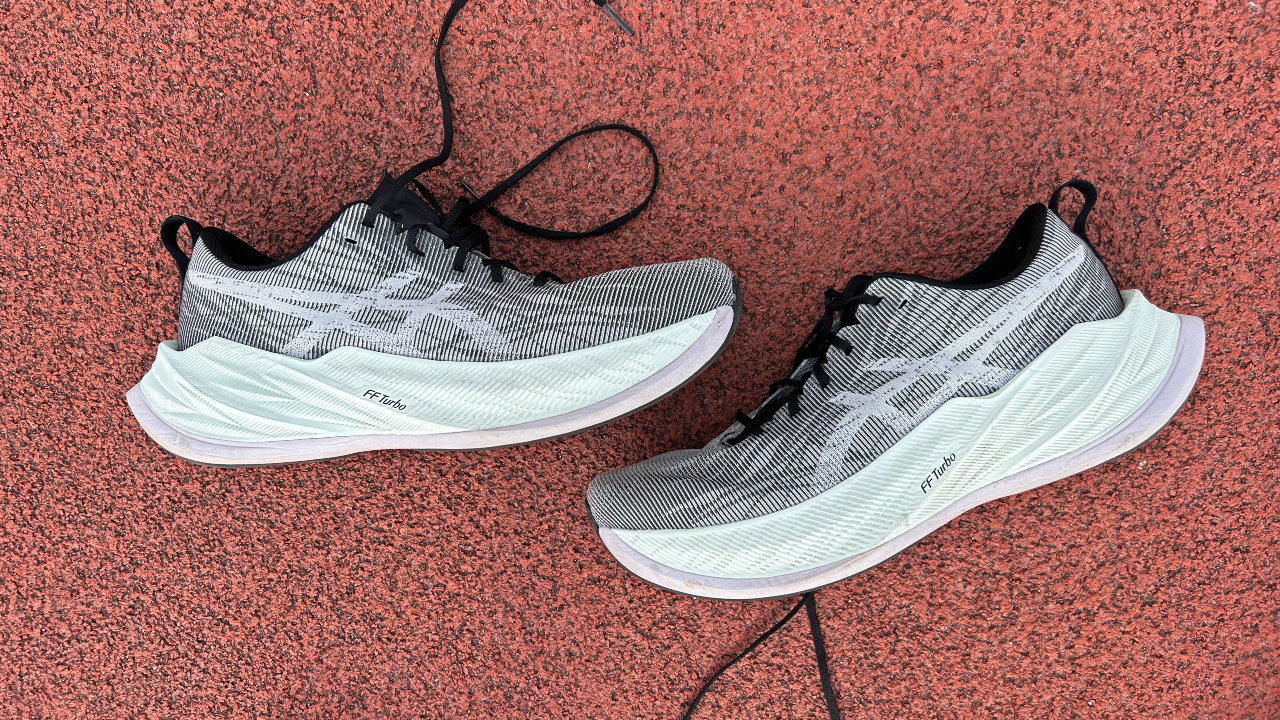
On paper, the Asics Superblast sounds like a ridiculous shoe. It has a stack height of 45.5mm at the heel, and its price is no less absurd, especially for a shoe without any plate in the midsole.
Once you start running in it, however, none of that matters because the Superblast is incredibly fun and versatile. It’s one of the best running shoes and the best all-rounder without a plate.
Asics Superblast Review: Price And Availability
The Asics Superblast launched in late 2022 with a price of $220 in the US and £210 in the UK, but this dropped to $200/£195 with the latest round of colors, which came out in July 2023. Even with the drop in price it’s still expensive, comparable to the best carbon plate running shoes, and significantly pricier than most training options.
Design And Fit

The Superblast is a highly cushioned shoe with a stack height of 45.5mm at the heel and 37.5mm at the forefoot for a drop of 8mm. That huge stack is made of two foams. The dominant foam is Asics’s FF Turbo foam—the same material used on the Asics Metaspeed Sky+ and Metaspeed Edge+ carbon super-shoes— and so far, the Superblast is the only training shoe in Asics’s range to use the FF Turbo foam, which is the brand’s bounciest and lightest material. Underneath the layer of FF Turbo is a thinner layer of FF Blast+ foam that is firmer and more durable.
To ensure the Superblast is stable there are sidewalls of foam your foot sits within, plus an internal heel counter to cradle the foot. It also has a wide base, especially in the forefoot, along with a rocker profile to roll you smoothly through your footstrike.
The upper is a lightweight and flexible mesh with padding around the collar. The shoe fitted well in my usual running shoe size: It was roomy and comfortable but still felt secure enough when running fast.

There is not a lot of rubber on the outsole, though the main impact areas in the heel and forefoot are covered with Asics’s AHARPLUS rubber, and the shoe gripped well in wet and dry conditions. There is a lot of exposed foam on the outsole, but this hasn’t shown undue signs of wear after 30 miles. The little holes in the foam have a habit of picking up small stones but these aren’t noticeable when running, thanks to the large stack of foam.
Given the size of the shoe, the Superblast is remarkably light at 8.8oz/251g in my men’s US 10/UK 9. This sets it apart from other max-stacked shoes, like the Asics Gel-Nimbus 25, and points to the fact the Superblast is built to handle fast runs as well as easy ones.
How I Tested This Shoe
I’ve run just over 30 miles (50km) in the Asics Superblast, using it for a variety of runs, among them recovery runs, track sessions and a couple of longer runs including a half marathon. I’ve also tested many other super-trainers and most of Asics’s current range.
Running Performance

I didn’t expect to love the Superblast as much as I do. It seems a superfluous shoe until you run in it, at which point you realize its role is simply to make running more fun. It’s amazingly light for such a big shoe and doesn’t feel unwieldy when running, and cruising through long runs in particular is enjoyable in the shoe.
While the midsole is undoubtedly bouncy, it isn’t overly squishy and the shoe felt stable to me. The rocker is noticeable but not too aggressive, and overall the Superblast feels almost subtle on the run—with the main clue to its size being the lack of feel for the ground you have while using it.
I took it to the track to use alongside the Asics Magic Speed 3 plated trainer for a session of 400m and 800m reps at a fast but not flat-out pace. I was surprised at how good the Superblast felt when running 2min 40sec 800 reps. It doesn’t feel like you’re running fast in the shoe because of how cushioned it is, but you can hit fast paces easily because of how light it is and the bouncy midsole foam.
While the Magic Speed 3 is more propulsive and better for this kind of session, the Superblast was great on the track, and is more enjoyable to use for almost every kind of run on the road.
I don’t have it down as a great short-distance racing shoe, and obviously a carbon super-shoe would be best for races of any distance. But if you’re not using a plated shoe and don’t mind the 40mm+ stack, the Superblast would be a top option for half marathons and marathons.
Is The Asics Superblast Worth It?

The Superblast is a fantastic running shoe and I’d keep an eagle eye out for sales that make its price more reasonable. Even at full price, its versatility may make it worth the outlay, since it can handle every kind of run. However, you can get similarly versatile shoes for less, like the Saucony Endorphin Speed 3 or Adidas Adizero Boston 12, which are the best super-trainers available and have plates (or rods in the case of the Boston) in the midsole to add propulsion for faster runs.
If you’re undaunted by the price, I’d pick the Superblast as an option for your running shoe rotation because it’s so much fun to run in. If you’re thinking in more practical terms, the Endorphin Speed or Boston is probably a smarter buy. They’re cheaper and have a slight edge for speed sessions and races.







